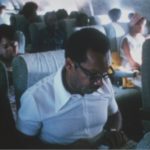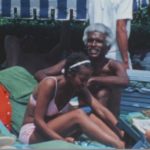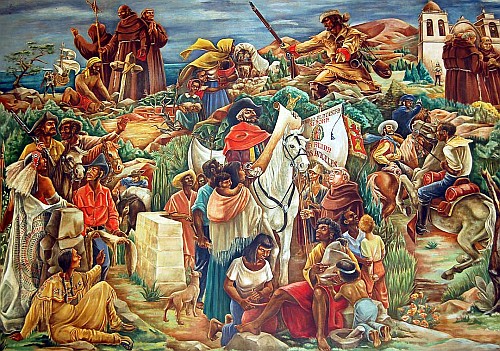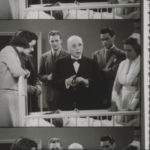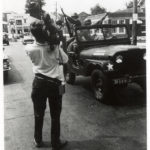Insuring a Rich Archive of African American Life
When three insurance agents founded the Golden State Mutual Life Insurance Company in 1925 in Los Angeles, they had two clear goals. One was to provide insurance protection for fellow African Americans, who were consistently denied coverage in the segregated United States; the other was to be able to offer “dignified employment” to African American colleagues.
Plenty of people he knew had had problems, finding the latter.
So receptive were African American citizens to the company’s services that Golden State Mutual, started by William Nickerson Jr, George A. Beavers Jr, and Norman O. Houston, became one of the largest Black-owned companies west of the Mississippi River, spreading throughout the western half of the United States during the 84 years it operated, until 2009.
The personnel at Golden State Mutual clearly knew not only how to run a highly successful company, but also how to have a fine time, professionally and socially, judging by films and a wide range of other records the company kept. Among the company’s approaches to changing the lives of African Americans were such forms of community outreach as working with many community organizations, holding many social events, and building an important collection of African American art.
The University of California at Los Angeles Library Special Collections is working to preserve a trove of materials from throughout the company’s history, including films. The library’s efforts are benefiting greatly from the goodwill towards the company that remains evident in Los Angeles, says Yasmin E. Dessem, the UCLA library’s head of audiovisual preservation. “Fortunately the donor of the material, a son of one of the co-founders, is still alive, in his 90s,” she says. “He’s done us the great honor of coming to spend time with us and look at the materials, and comment on them, and he has a great memory.”
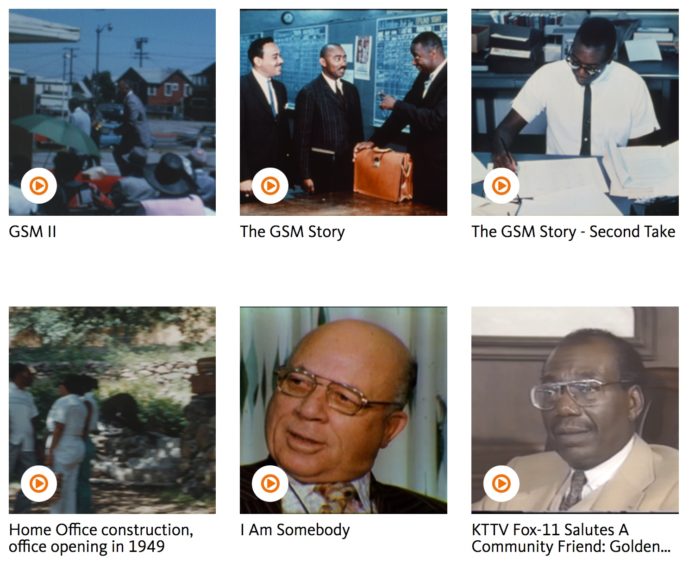
Samples of film footage on Calisphere’s page for Golden State Mutual.
A vast collection
Throughout the company’s history, Dessem says, the founders and later employees were committed to self-documentation in many media formats. The result is a rich collection of documents, images, and sounds that “illustrate the shifting demographics of Los Angeles, and the empowerment of a community,” Dessem says.
The material now at the UCLA library — some 175 linear feet of it — includes minutes books, annual reports, corporate history files, ledgers, public relations and advertising files, correspondence, photographs, scrapbooks, plans, reports, agreements, manuals, policy specimens, publications, architectural drawings, awards, memorabilia, and files about the company’s historical murals and Afro-American art collection.
The UCLA Library has been placing facsimiles of many items on the Calisphere website, a portal to digital collections from California libraries, archives, and museums. The Golden State Mutual area has some 2,400 items, including sound and film clips that can be streamed, with more to come.
On the site, viewers can watch footage of company picnics, evenings, and other social events, with casts of sometimes hundreds of employees. If some of the film clips are indifferent in their production values, they nonetheless convey the collective accomplishment of an extraordinary company. The films include, for example, Kodachrome home movies shot in a segregated Los Angeles, where black Americans were generally restricted from access to many parks and other public areas, so gravitated to some others. Golden State Mutual employees and their families had, for example, a rollicking good time at a 1947 company annual picnic in the city’s Val Verde Park, which was known as the “Black Palm Springs.” Other events were held at a part of Santa Monica Beach where African Americans could gather without harassment, and that was popularly known as “The Ink Spot” or “Ink Well Beach.”
The material, says Dessem, “is a collection of African American materials but it also showcases the history of L.A. over such a long period of time.” The achievements of Golden Mutual Life Insurance, she says, was “a story that resonates with quite a lot of people”; former employees who help her staff add descriptions and other metadata to the records often become “quite emotional,” she says.
Dessem notes that the company actively sought to train African American citizens in various trades, not just insurance brokerage. For example, it might employ a serviceman returning from the war in Vietnam, and put him to work in one of the home office’s in-house departments: its print shop, which prepared all the company’s policy and promotional materials. Dessem says she spoke to one former employee who started with Golden State Mutual in that way, and remained with the company for 30 years: “He showed me photographs of when he started with the company, many years ago. The company made a big difference in many lives, because it provided a lot of professional development and opportunities and entry into the middle class, for a lot of people.”
A curiosity among the films in the collection is Holiday in Acapulco, or How to Travel in a Group… and enjoy every minute of it (below), a 28-minute promotional film made in 1972 by Western Airlines, the self-styled “Champagne Airline.” It featured vacationing employees of Golden State Mutual and another L.A. institution, the West Adams Community Hospital. It began by showing Acapulco-bound employees greeted by airline staff – booking agents, airline executives, and flight stewards and even crew — who are, somewhat improbably, virtually all African American.
{Click on an image to expand}
Frame grabs from “Holiday in Acapulco.”
For all that, a significant aspect of the film is that it was clearly pitched to a black middle class that companies like Golden State Mutual were playing an important role in creating. Says Dessem: “Once the advertising industry realized that there was a whole untapped market of African Americans, there was a lot of promotional material geared towards that audience.”
Humble beginnings, extraordinary growth
The founders of Golden State Mutual proceeded from a sense of great need, and threat.
William Nickerson, Jr. was working as an official of the Texas-based American Mutual Benefit Association when, one day in 1921, the local branch of the Ku Klux Klan identified him as antagonistic to its message of hate and burned a cross on his front lawn.
Nickerson immediately made plans to move West, to Los Angeles. There, he found that the city’s insurance agencies routinely shut out African American Angelenos. Those numbered, at that point, only 40,000. The insurance industry marked them down as either uninsurable or extraordinary risks. If Black residents of Los Angeles could get insurance coverage, at all, it was only at punitively premium rates.
Nickerson determined to start a company that might rectify that situation. He studied relevant California law, and then recruited a fellow Black insurance salesman, Norman O. Houston, and businessman George A. Beavers Jr to undertake the formation of their own, non-discriminatory company. To do that, they had to recruit 500 potential subscribers, which they soon did. They worked from a one-room office in Los Angeles, and quickly grew and did booming business. Within three years, the company had branches in four California cities, and 100 employees.
Surviving the Great Depression, by the end of World War II the company had written $24-million in policies, and had expanded as far as Illinois and, in an historical irony, given Nickerson’s experiences, Texas.
Nickerson died in 1945, but under Houston and Beavers’ leadership, the company continued to grow, and at its peak operated in 14 states, with more than $4-billion in policies.
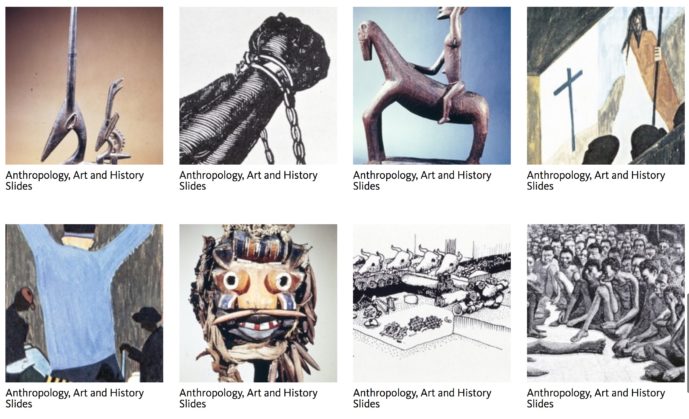
Examples of images in the collection, including items in the company’s art collection.
In another historical irony, racial integration from the 1960s onwards led to the decline of the company, and many others that had grown up to mitigate the harms of segregation and racism. After decades of gradual decline, in 2009 the company was placed into conservation by the California Insurance Commissioner and sold to IA American Life Insurance Company, which guaranteed to maintain existing policies.
Golden State’s art collection had been sold at auction two years earlier. Under the curation of its originator, William E. Pajaud, it had grown to include 200 works by Charles Alston, Richmond Barthé, David Hammons, Varnette Honeywood, Betye Saar, Charles White, Hale Woodruff, and other noted African-American artists.
That the company “touched many lives in L.A.” has been borne out in UCLA’s efforts to preserve its legacy, says Dessem. In documenting the vast trove of records, “we’ve been interacting with former staffers,” she says. “Once company closed, and went out of business, they still maintained their ties through a group called the Golden State Mutual Alumni Association, they meet monthly, and they’ve invited us to a few of their meetings, where we’ve been able to do crowd sourcing to try to identify all the many people who show up in the materials.”
Preservation and documentation of the collection
The collection came to UCLA Special Collections in two installments, the first back in the 1980s, the second after the company went out of business.
In 2012 and again in 2016, the Haynes Foundation awarded the UCLA library grants to process all the materials from those accessions.
The materials are held in the Southern Regional Library Facility, on the UCLA campus. Established in 1987, the facility holds library materials, archives, and manuscript collections from the many institutions of the University of California.
Dessem, along with Kelly Besser and Shani Miller at the UCLA Library Special Collections, has been processing and digitizing the collection, with support from the National Film Preservation Foundation in addition to the Haynes Foundation funding.
Until the digitization project began, access to the material was limited. Anyone interested in the material could at best come to a UCLA Library reading room but view materials only in clumsy, or even obsolete formats. Audiovisual material could be played, for example, on a Cinescan, an editing device.
But UCLA, like many institutions, has a policy that it won’t allow the playing of archival material in its reading rooms, for a variety of reasons including that reading-room staff aren’t trained in playing or maintaining material, and even an experienced projectionist can tear film.
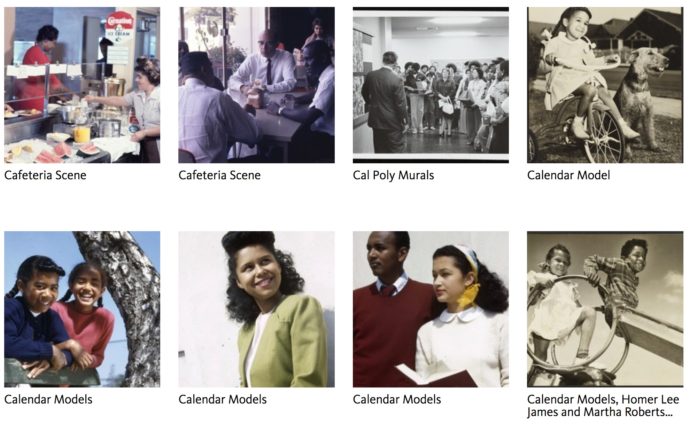
Examples of images in the collection, including child and other models for the company’s promotional calendars.
Dessem says of the Golden State Mutual materials, “our concern was to protect the original material as much as possible and digitization seemed like the best way to make it accessible and also that the original material wasn’t being touched, any more.”
Consulting the dwindling numbers of remaining Golden State Mutual Life workers and their descendants has provided many gratifying moments for her and her colleagues, Dessem says: “When we do go out and show photographs or films from the collection, people start running up and pointing at who they know. Everybody knows somebody in the films. I have great pictures from the first time that we met with them in a small community space and they were grabbing broomsticks, and running up to point at people and arguing over who was who.”
Among those to see the material has been a grandson of the founder. Says Dessem: “There is a little bit of footage of Mr. Nickerson in a home movie in the collection. His grandson had never seen moving images of his grandfather, and was very touched by that.”
In the original accession of material, in the 1990s, Golden State Mutual and UCLA included a clause in their agreement to specify that, if the company closed, rights would revert to UCLA. That has made placing material online much easier, says Dessem. “It made obtaining a grant and making the material available online much easier.”
To date, she and her colleagues haven’t been able to digitize and post all the materials – many photographs remain to process. “There were thousands and thousands of photographs and we tried to pick a nice selection,” she says. “Hopefully in the future the rest of it can be digitized.”
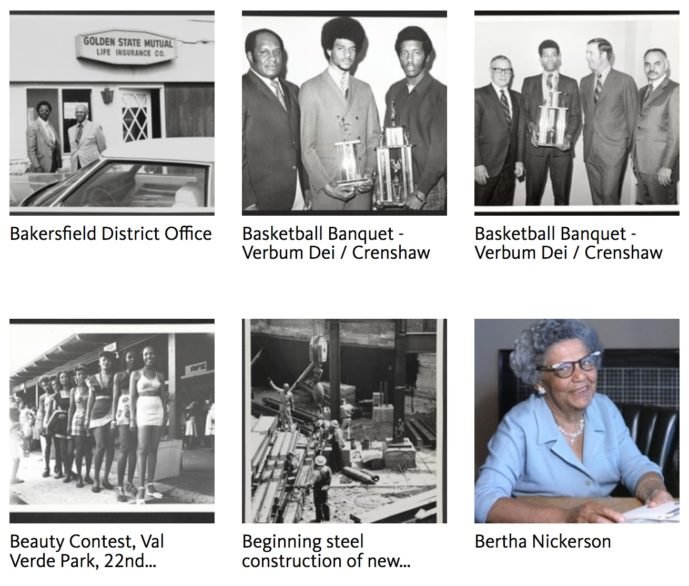
Examples of images in the collection.
Conservation of the 1947-built headquarters
Among the films is one about the construction of the company’s headquarters building in Los Angeles, in 1947. After the company closed down, the building became a conservation and restoration issue, itself.
In 1949, the company moved into the building, a trapezoidal structure designed in the Late Moderne style by a renowned architect, Paul Revere Williams. He was the first black member of the American Institute of Architects, and in addition to designing many public buildings, was the architect to many celebrities, including Lucille Ball and Desi Arnaz, Lon Chaney, Frank Sinatra, and Barbara Stanwyck.
When Golden State Mutual closed down in 2009, the State’s Conservation and Liquidation Office prepared the company’s assets for sale. Meanwhile the building, which had already been much altered, rapidly fell into disrepair.
The California conservation office researched the history of the building, even interviewing original occupants to get a sense of what the structure had originally been. Conservators restored the building to its 1949 appearance by removing layers of alterations and repairing extensive water damage. They restored original doors and windows, reopened covered window spaces, and restored interior spaces.
The City of Los Angeles designated the building a Historic Cultural Monument in 2011.
The work included restoring two large lobby murals that depicted African-American contributions to the state: images of early black Californians including explorers, cowboys, and oil riggers. The company had commissioned the murals: “Settlement and Development,” by Hale Woodruff, and “Exploration and Colonization,” by Charles Alston.
In 2009, Community Impact Development, a nonprofit social services group from South Los Angeles, bought the building. State officials told that group that they would remove and sell the murals to settle debts of the Golden State Mutual Life Insurance Company.
Among potential buyers was the Smithsonian Institution, for its museum of African American heritage and art on the National Mall in Washington, D.C., but the Smithonian quickly withdrew its bid due to community opposition. It had reportedly offered $750,000 for the murals, although they have been appraised at up to $5 million.
In 2014, the dispute was settled, with an award of the murals to the new owner, Community Impact Development.
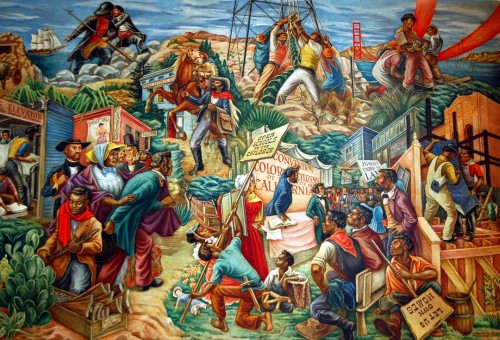
The Golden State Mutual Life Insurance Company headquarters murals: “Settlement and Development,” by Hale Woodruff, and (below) “Exploration and Colonization,” by Charles Alston.
— Peter Monaghan
Previous Post: Reviewing the Films of Expo 67
Next Post: Jack Shaheen’s Preservation of a Troubling Film Legacy

